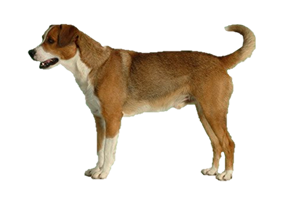Austrian Pinscher
Austrian Shorthaired Pinscher, Österreichischer Pinscher

The Austrian Pinscher is a member of the schnauzer/pinscher family of dogs. This includes breeds such as the Schnauzers, Miniature Pinscher, German Pinscher, and Affenpinscher. As with the other dogs in this grouping, the Austrian Pinscher was developed as an all-purpose farm dog. Their talents include driving and guarding livestock, property guards, and vermin control.
The exact origins of the name “pinscher” are unknown. Some sources believe it is from an archaic German word, others French, but nearly all agree that it refers to the way these dogs attack their main prey - vermin. Today the word pinscher is often recognized as a synonym for terrier, even though the two families are not related and work quite differently.
Austrian Pinscher Standards
- 14-20"
- 26-40 lbs
- medium-sized pinscher
- small button ears
- tail is medium length, set high
- coat is think and short to medium length
- black and tan
- brownish yellow
- russet gold
- stag red
- may have white markings
History of the Austrian Pinscher
As with the other pinschers, the exact ancestry of the Austrian Pinscher is unknown. Paintings exist from the 18th century depict dogs almost identical to today’s breed, however, most experts agree dogs of this type are much older. Perhaps having first accompanied the Germanic tribes as they invaded the Roman Empire. Along with the spitzen, it is believed pinschers are the oldest of the German breeds. The most common theory is that their ancestors were from Scandinavian dogs, similar to the Danish/Swedish Farm Dog.
Whatever their ancestry, pinscher-type dogs have been known throughout Germany and Austria for centuries. The Austrian breed is distinct from its German counterpart and both were influenced by other non-pinscher breeds. Since they were originally bred solely for their working abilities there were almost certainly unique varieties of pinschers from different regions. Each one adapted to their own small homeland.
During the 1800s a large number of German breeds were imported into Austria. It is unclear what (if any) native breeds were lost during this time period. Meanwhile the Austrian Pinscher it continued on, kept by farmers that had no need or income for an expensive breed. As with most European breeds, the line was decimated by WWI but kept pocketed strongholds in rural areas.
In the 1920s Earl Hauck became interested in the breed, he considered it to be the oldest of Austria’s native dogs. He began acquiring them and started a breeding line, leading to the Austrian Pinscher being recognized in 1928. At the time the German Pinscher and Schnauzer were still considered one breed. To differentiate the Austrian Pinscher from their German counterparts it was given the name Österreichischer Kurzhaariger Pinscher (Austrian Short-haired Pinscher).
Shortly after its recognition, Austria was annexed to Germany by Adolf Hitler and during WWII the purebred line of Austrian Pinschers almost ceased to exist, while the farm dogs struggled on. After the war there was little interest in the breed, few Austrians even knew of its existence. By 1970s on one female registered dog remained. Once again its fanciers came to the rescue, scouring the countryside to find those that matched breed standards. They were successful in saving the bloodline, and the Fédération Cynologique Internationale changed its name to Austrian Pinscher in 2000.
Despite these dedicated fanciers, the Austrian Pinscher remains rare, even in its homeland. With low registration numbers each year, their future is far from secure.
Related Breeds:
